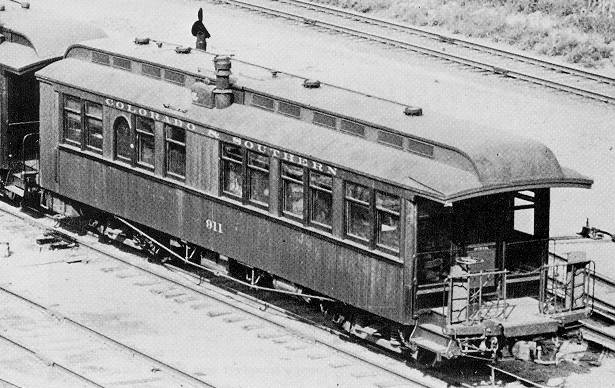Pay Car #051
|
 |
| A = Anteroom O = Office C = Closet
S = Sections
T = Toilet W = Saloon Floor plan of pay car #026 at 1885 renumbering according to Ehernberger/UP-55. |
Regarding color, Ken Martin had this to say in an e-mail posting to the DSP&P
discussion group dated 29 June 2002:
|
“ ... I have a paint chip I got off C&S 911 back in 1978 and had (an) artist friend (who was doing restoration work at the California RR Museum) analyze it. He has a bottom layer of “Brown” over a gray primer, it then has a “light olive green” layer with a coat of “varnish”. So they were painted brown originally not a “tuscan red” however this didn’t last long before they switched to green. Now don’t ask me how to define what the shade of green is because I don't have the artist eye for colour, that’s why I had a friend do it. To me green is green.” |
(For further discussion of car colors see the COLOR topic on the FLEET INFORMATION page.)
HISTORY
Pay car #051 was begun at the South Park’s Denver shops in May 1880. The South Park’s track had reached Buena Vista, and the deal had been worked out whereby it would go into booming Leadville over the Rio Grande’s tracks. The South Park itself was booming, and a booming railroad needs some private cars: so they began building office car #050 and pay car #051.
There can be no question that these cars were built from assemblies acquired from an eastern car builder. When you look at all that goes into such a car and the facilities required, to build a car from scratch in two months would be virtually impossible. But this they reportedly did. Pay car #051 rolled out of the shops in July 1880. Though it preceded office car #050, which was out-shopped in October, it is clear that the office car took precedence, with the lower number.
Pay car #051 was probably put into service quite quickly, rolling up and down the line bringing South Park employees their wages. It ran in a special train, generally pulled by locomotive #2, an old Dawson & Bailey 4-4-0.
|
“The special train consisted of the pay car, which resembled a miniature bank furnished with tables, chairs, a safe, and money cage, and the caboose, where the paymaster lived en route. The train stopped along the line at stations and sidings, wherever it came upon railroaders. Each man’s pay was determined in advance at the Denver office from time reports turned in daily to the superintendent. The paymaster doled out the pay in gold coins.” |
When the Union Pacific renumbered cars in 1885, pay car #051 became pay car #026, and was presumably continued in that service. The best guess is that it continued in that service under the Denver, Leadville and Gunnison with the same number until late 1894 when the DL&G and UPD&G both came under Receiver Frank Trumbull and operation started as if they were one railroad.
Shortly thereafter, coach #176 (former Pullman Palace sleeping car South Park) was rebuilt as a business car and designated UPD&G business car #1, while pay car #026 was rebuilt as a business car and designated DL&G business car #2.
When the Colorado & Southern was organized in 1899, DL&G office car #2 went on the initial roster as “Official” car #011, but by the time it was relettered 16 November 1899, it had changed to B-2. It kept that designation in the C&S 1906 general renumbering, but for some reason was designated #911 in 1911.
Just how business car #911 was used during the ensuing years is unknown, but it was apparently used on the C&S broad gauge lines as well as the narrow. Photo #8 shows it on standard gauge trucks, apparently being used in the 1930s as a track inspection car.
Car #911 was almost scrapped in 1938, but the cost to cut it up would have been $30, while the cost to burn it and then cut up the remaining scrap would have been $20. The low price of scrap was all that saved it. It was stored in Denver for awhile, then sometime in the mid '40s was moved to the CB&Q shops in Aurora, Illinois, where it joined coach #76, RPO #13 and 2-6-0 #9, which had been exhibited at the New York World’s Fair in 1939.
In 1948, car #911 was repainted as the “Leadville” and ran with the Mogul and the two other cars as the Deadwood Central at the Chicago Railroad Fair (1948-1949). This equipment was returned to the CB&Q shops where it stayed until 1957, when it was moved to the Black Hills Central Railroad at Hill City, SD (owned by the CB&Q). In 1988, all were donated to the Colorado Historical Society and moved to the Georgetown Loop Railroad at Silver Plume, Colorado.
 |
|
(2) Car #911 in Denver coach yard, 1933. Richard B. Jackson photo at Ferrell/C&S-206, Kindig-388(d) and Wagner-340. |
